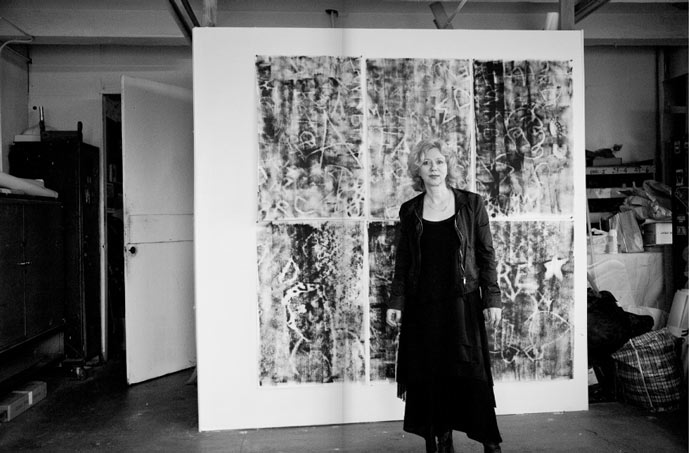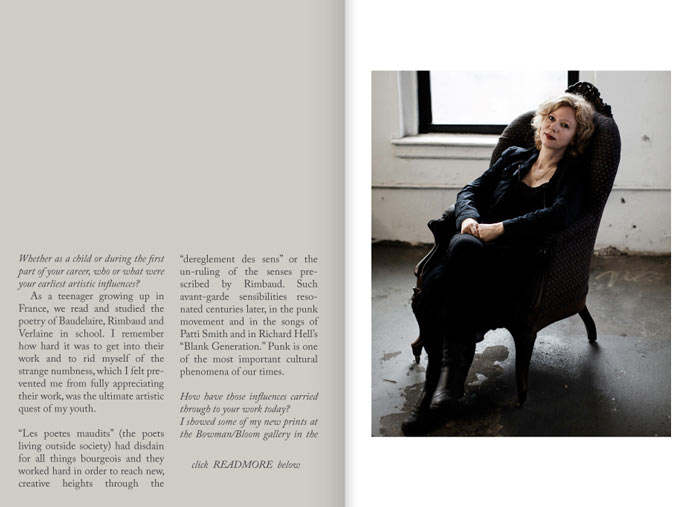|
Le Telegramme, May 2016, Un cafe recontre jeudi dernier, http://www.letelegramme.fr/morbihan/arzon/parc-naturel-regional-un-cafe-rencontre-jeudi-dernier-16-05-2016-11069536.php The Huffington Post, Feb, 2013 Imprints of Sidewalk Grafitti, http://www.huffingtonpost.com/brigitte-engler/sidewalk-graffiti-_b_2615579.html |
|||||||
INTERVIEW -Awanted magazine, 2009. |
|||||||
|
|||||||
1; Whether as a child or during the first part of your career, who or what were your earliest artistic influences? As a teenager growing up in France, reading and studying in school the poetry of Baudelaire, Rimbaud and Verlaine, I remember how hard it was to get it. To rid myself of this strange numbness I felt that prevented me from appreciating fully the work of these poets was the ultimate art quest of my youth. The disdain of “ les poetes maudits” for contentment and everything bourgeois, or their decision to go as far down as possible to reach new, unexpected heights through the “dereglement des sens”, the unruling of the senses prescribed by Rimbaud, resonated in the Punk movement, the most important cultural phenomena of our times, in the songs of Patti Smith and Richard Hell’s blank generation. 2; How have those influences carried through to your work today? I showed some of my new street prints at the Bowman/Bloom gallery in the Nincompatibles show. Walking around my neighborhood with my dog, I find images and messages inscribed in the fresh cement of the sidewalks and I make mono-prints from these engravings. 3; Hailing from Paris, did you ever view American artists/art any differently than that of either France or other countries? At the Beaux-Arts School in Paris, I was fortunate to study with the great art historian Gaetan Picon. He was amazing when he talked about the abstract expressionists but his class stopped at Rothko. 4; How is American culture and landscape conveyed through your work and has it changed over the years since you have lived here? Pretty soon after my first trip to New-York, my artist friend Annie Ratti, encouraged me to apply to the Whitney Program. Annie introduced me to Ron Clark, the head of the program, while he was in Paris, and we talked about the work of the philosophers Deleuze and Guattari, Barthes that I was reading. I got in and moved to New-York. I struggled in english with the signifier and the signified but the weekly visits of the great american artists, among them Vito Acconci or Phil Glass who came to talk about their work was extremely valuable. So the whole question of nationality bugs me. To have both cultures creates a dialectical situation that fosters creativity but since I have been working here for more than 2 decades, I would say that I’m making American art. 5; Would you say your work is driven by form or content? (As in, does it develop from an idea/seek to express an idea, or is it more about formal aspects As Bob Dylan would say on his radio show: “ Through the mind and your ass will follow”. I’m definitely into Conceptual Art but art is experienced physically. 6; How does your environment (i.e. hometown, cityscapes, rural landscapes, etc.) affect the work you create? Everyone here was affected by 9/11. It’s a coincidence that I was going through my files and as the Towers were falling, I had in my hands an old print I had worked with before and saved. A scene of a panic on the Brookliyn Bridge on Memorial Day in 1883. It’s a bit of an obsession but this illustration, a wood engraving from the 1880’s, fascinates me. I enlarged it and cropped it. I made drawings and embroideries from it, both historical and decorative. Some of the drawings were published with a text on Panic by the French theoretician Sylvere Lotringer. Yet, I’m not done with this engraving, as I’m working more in between legibility and abstraction. 7; How significant is the contrast of using centuries-old techniques such as engraving, etching and printmaking in creating modern art? I’m interested in paradoxes within singular forms. The works I showed in Nincompatibles are anachronic. |
|||||||
 |
|||||||
REVIEW - Michelle Tea. -Blog.sfmoma.org/2009 - full article here |
|||||||
The Bowman/Bloom Gallery is in this sort of underground space, you take stairs down under the ground and find yourself in this very tiny white place that has you know art on the walls. Richard Hell’s had scrawled charcoal commentary and square blocks of bright color, plus some phallic illustrations that looked half like an instructional diagram and half like something scribbled on the wall of a men’s room. Richard Hell is of course an Original Punk, singer for Richard Hell and the Voidods whose album Blank Generation is full of the anthems of that time (70s) and place (NYC). He is also a writer and a painter. Walter Robinson is a painter, too, and I really liked his paintings, mostly small but one big one, portraits of women who appear to maybe be porn actresses or in the midst of some sort of sexed-up occupation. They almost looked a little paint-by-numbers-ish, with bold, fat, visible brushstrokes. I have one as my cell phone wallpaper right now. The final artist I’m not posting any photos of, cause they came out lousy and this is tragic because her project is so genius: the artist Brigitte Engler is doing rubbings of things carved into the sidewalks of the Lower East Side. Messages, birds, and spiked helmets are some of the images she captured, and as this is a gentrified neighborhood whose charmed filth is famously vanishing, her project isn’t only clever and cool to behold, it is the sort of art that feel like a necessary historical document. |
|||||||
